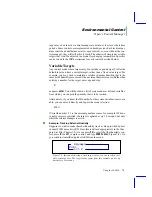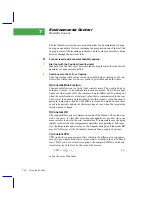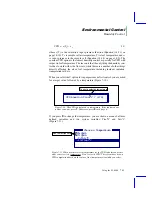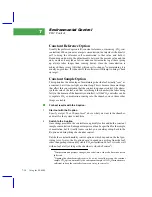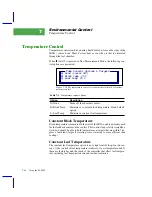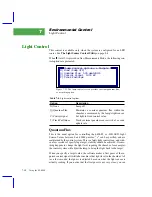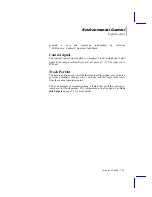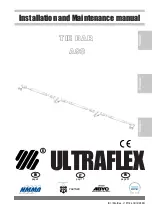
Environmental Control
CO2 Control
Using the LI-6400
7-15
Interaction with Humidity Control
There is interaction between the constant sample CO
2
option, and the con-
stant humidity control options. If the humidity controller is changing the flow
rate to try to achieve some target humidity, the CO
2
concentration in the leaf
chamber is going to be responding as well. Generally this causes the CO
2
con-
troller (when itÕs doing the S option) to sit back and wait until things stabilize,
before attempting adjustments.
The result is that the S CO
2
option will work with the H, R, or V humidity
options, but expect longer system equilibration times.
Constant Control Signal Option
The C) option has two purposes: as a diagnostic, and as an option that will
provide the fastest equilibration time after a change in CO
2
target. This option
simply sets the controller to a target value (voltage, not CO
2
concentration),
and makes no further adjustment. Thus, when you specify a target, you may
not know exactly what the final concentration will be, but youÕll be assured
the controller will be making no changes, so any change or fluctuation you
see in reference CO
2
concentration will be coming from something else
(leaks, bad soda lime, flow rate changes, long term drift of the controller,
etc.).
CO
2
Mixer Calibration
There is a relation between the CO
2
mixerÕs control signal, and the resulting
CO
2
concentration measured in the reference cell. In fact you can see a plot
of the relation that your instrument is currently using by selecting Ò_CO2
Mixer - Plot curveÓ from the Calib Menu. A typical plot is shown in
Figure 18-15 on page 18-23.
The CO
2
control software uses this calibration to come up with a first guess
when youÕve specified some target CO
2
concentration. If you find (when op-
erating in constant reference concentration mode) that the first guesses donÕt
seem very good, you can generate a new set of calibration points for it to use,
described in
Summary of Contents for LI-6400
Page 1: ...Using the LI 6400 Portable Photosynthesis System ...
Page 15: ...Part I The Basics ...
Page 16: ......
Page 174: ...Making Measurements Answers to Questions 4 56 Using the LI 6400 4 ...
Page 175: ...Part II Useful Details ...
Page 176: ......
Page 200: ...Standard Tools Power ON Hooks 5 24 Using the LI 6400 5 ...
Page 214: ...Real Time Data Real Time Graphics 6 14 Using the LI 6400 6 ...
Page 234: ...Environmental Control Light Control 7 20 Using the LI 6400 7 ...
Page 244: ...Light Sensor Considerations Gallium Arsenide Phosphide GaAsP Sensor 8 10 Using the LI 6400 8 ...
Page 288: ...Data Logging Making Your Own AutoPrograms 9 44 Using the LI 6400 9 ...
Page 289: ...Part III Working With Files ...
Page 290: ......
Page 312: ...The LPL File System Troubleshooting 10 22 Using the LI 6400 10 ...
Page 340: ...Downloading Files Using a Data Capture Program 11 28 Using the LI 6400 11 ...
Page 375: ...Part IV Configuration Issues ...
Page 376: ......
Page 420: ...Defining User Variables Old Style vs New Style 15 18 Using the LI 6400 15 ...
Page 454: ...Using an Energy Balance Further Reading 17 12 Using the LI 6400 17 ...
Page 455: ...Part V Maintenance Troubleshooting ...
Page 456: ......
Page 572: ...Troubleshooting Useful Information 20 46 Using the LI 6400 20 ...
Page 593: ...Part VI Programming ...
Page 594: ......
Page 622: ...Programming with LPL Compiler Directives 22 28 Using the LI 6400 22 ...
Page 846: ...Index I 16 Using the LI 6400 ...





